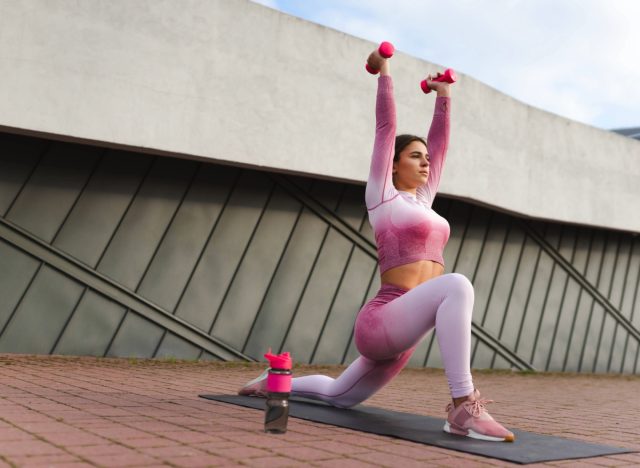People Swear by 'Exercise Stacking' on Weekends: 'I Feel So Validated by This'

Being a "weekend warrior," or practicing "exercise stacking" on weekends, comes with its benefits. According to recent research published in Obesity, leaving your workouts solely for the weekend—and exercising hard—can be just as effective as exercising throughout the week when it comes to burning fat and achieving your fitness goals.
We spoke with Tyler Read, BSc, CPT, the founder of PTPioneer.com and a personal trainer who has been involved in the health and fitness world for the past 15 years, who breaks down everything you need to know about exercise stacking, along with how it can speed up your progress. Keep reading to learn more, and when you're finished, check out the 6 'Power Foods' That Helped This Woman Lose 100 Pounds.
What is exercise stacking all about?
"Stacking exercises refers to the practice of cramming essentially an entire week's worth of workouts and exercise into just a few back-to-back days, such as on the weekend," explains Read. And research backs up the benefits.
TikTok user Kevin Gendreau, a board-certified obesity medicine doctor, posted a video with the caption, "I'm a weekend warrior—are you?" He mentioned a 2022 "weekend warrior" study published in JAMA Internal Medicine, which revealed that you can lower your risk of all-cause mortality by squeezing all of your exercise for the week into the weekend.
"So, for example, you can work out for 75 minutes Saturday and 75 minutes Sunday and still get the same all-cause mortality benefit as if you were to disperse your workouts through the week," Gendreau explains. "This was a game-changer, and it means that people with super busy schedules throughout the week can actually push off their workouts to the weekend. And whether you work out through the week or you just work out really intensely Saturday and Sunday, you still have a benefit of decreased myocardial infarction or heart attack, decreased risk of stroke, decreased risk of heart failure, and even atrial fibrillation."
TikTokers were quick to comment, with one user writing, "I feel so validated by this," and another commenting, "Love this!"
How can exercise stacking help you progress?

If you lead a hectic, jam-packed lifestyle during the week, exercise stacking can help you be productive with your fitness goals over just a couple of days. "Research suggests that stacking may be as effective as spread-out exercise for general health benefits," Read tells us. This doesn't come without a caveat, though.
"Based on my knowledge of strength and conditioning for serious performance goals, the lack of recovery between the stacked workouts followed by the extended period without exercise may be detrimental," Read stresses. "However, for general fitness and making 'some gains' compared to 'no gains,' stacking is far better than nothing."
What are examples of exercise stacking?

When it comes to aerobic training, Read suggests stacking various forms of exercise like swimming, cycling, or running to add variety to your program and help steer clear of overuse injuries.
If you're working with weights, Read recommends performing total-body workouts with superset aspects, like push-pull, and incorporating several sites of a wide range of exercises. "Make sure you don't only focus on a single body part; instead, spread the love across all the muscles in your body to make sure they each get the work they need," says Read.
- Source: The associations of “weekend warrior” and regularly active physical activity with abdominal and general adiposity in US adults
- Source: Association of the "Weekend Warrior" and Other Leisure-time Physical Activity Patterns With All-Cause and Cause-Specific Mortality: A Nationwide Cohort Study









